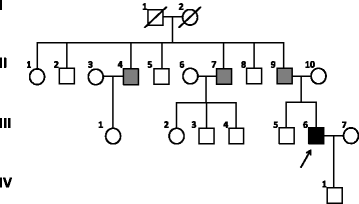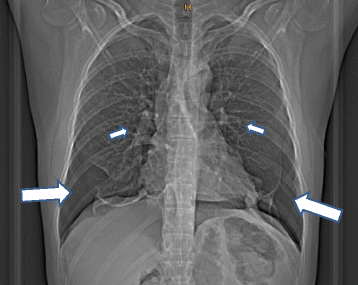Delayed diagnosis of Birt-Hogg-Dubé syndrome due to marked intrafamilial clinical variability: a case report
- PMID: 29548312
- PMCID: PMC5857113
- DOI: 10.1186/s12881-018-0558-0
Delayed diagnosis of Birt-Hogg-Dubé syndrome due to marked intrafamilial clinical variability: a case report
Abstract
Background: Birt-Hogg-Dubé syndrome is a genetic syndrome caused by mutations in the FLCN gene. The main symptoms are lung bullae and pneumothorax, benign and malignant kidney tumors, and facial fibrofolliculoma. The risk of pneumothorax is considerable between ages 20-40 years, but decreases markedly after this age range and first-time pneumothorax after age 50 years is rare. Fibrofolliculomas usually occur between ages 35 and 45 years, while the risk for kidney cancer increases steadily with age, starting in young adulthood. However, we demonstrate here that within the same family patients might develop symptoms significantly before or after the usual age range, obscuring the typical clinical pattern and delaying diagnosis.
Case presentation: The 43 year old index patient had a history of lung bullae and recurrent pneumothoraces starting 14 years earlier. His father (age 83 years) and one of the paternal uncles experienced their first pneumothorax unusually late after the age of 60 years. The uncle subsequently had four more pneumothoraces, and was diagnosed with kidney in his early 70s. Considerable differences in age of onset were also observed with regard to facial fibrofolliculomas that both paternal uncles developed very early around age 20 years, but which the father only started to show in his eighth decade. Birt-Hogg-Dubé syndrome was finally diagnosed when the index patient started to develop fibrofolliculomas within the typical age range.
Conclusions: The family described here illustrates that Birt-Hogg-Dubé syndrome can be difficult to recognize, if presenting with considerable intrafamilial clinical variability. With a life-time kidney cancer risk of about 14-35% the consequences of delayed diagnosis might be grave for the affected family members. The possibility of Birt-Hogg-Dubé syndrome should therefore be taken into consideration in apparently sporadic patients presenting with lung bullae and pneumothorax.
Keywords: Birt-Hogg-Dubé syndrom; FLCN; Kidney cancer; Lung bullae; Pneumothorax.
Conflict of interest statement
Ethics approval and consent to participate
All research was conducted according to the declaration of Helsinki principles. The study has been approved of by the ethical committee/institutional review board (IRB) of the Medical Faculty, University Hospital Munich, under the project-number: 508/16UE.
Consent for publication
Written informed consent for the publication of medical data (including those of the index patients son), images, and medical history of family members was obtained from the index patient.
Competing interests
The authors declare that they have no competing interests.
Publisher’s Note
Springer Nature remains neutral with regard to jurisdictional claims in published maps and institutional affiliations.
Figures



Similar articles
-
Birt-Hogg-Dube Syndrome with a Novel Mutation in the FLCN Gene.Genet Test Mol Biomarkers. 2017 Oct;21(10):632-634. doi: 10.1089/gtmb.2017.0070. Epub 2017 Aug 14. Genet Test Mol Biomarkers. 2017. PMID: 28805452
-
[Multiple spontaneous pneumothoraces revealing Birt-Hogg-Dube syndrome].Rev Mal Respir. 2011 Mar;28(3):355-9. doi: 10.1016/j.rmr.2010.08.015. Epub 2011 Feb 23. Rev Mal Respir. 2011. PMID: 21482341 French.
-
[Are multiple trichodiscomas/fibrofolliculomas the Birt-Hogg-Dubé syndrome?].Arkh Patol. 2021;83(3):45-51. doi: 10.17116/patol20218303145. Arkh Patol. 2021. PMID: 34041896 Review. Russian.
-
Birt-Hogg-Dubé syndrome: an underdiagnosed genetic tumor syndrome.J Dtsch Dermatol Ges. 2018 Mar;16(3):278-283. doi: 10.1111/ddg.13457. J Dtsch Dermatol Ges. 2018. PMID: 29537177 Review.
-
[Birt-Hogg-Dubé syndrome: an update].Actas Dermosifiliogr. 2012 Apr;103(3):198-206. doi: 10.1016/j.ad.2011.07.009. Epub 2011 Sep 19. Actas Dermosifiliogr. 2012. PMID: 21937013 Review. Spanish.
Cited by
-
Kidney cancer characteristics and genotype-phenotype-correlations in Birt-Hogg-Dubé syndrome.PLoS One. 2018 Dec 26;13(12):e0209504. doi: 10.1371/journal.pone.0209504. eCollection 2018. PLoS One. 2018. PMID: 30586397 Free PMC article.
-
Matching clinical and genetic diagnoses in autosomal dominant polycystic kidney disease reveals novel phenocopies and potential candidate genes.Genet Med. 2020 Aug;22(8):1374-1383. doi: 10.1038/s41436-020-0816-3. Epub 2020 May 13. Genet Med. 2020. PMID: 32398770 Free PMC article.
-
Bibliometric Analysis of Birt-Hogg-Dubé Syndrome From 2001 to 2021.Front Med (Lausanne). 2022 Apr 11;9:857127. doi: 10.3389/fmed.2022.857127. eCollection 2022. Front Med (Lausanne). 2022. PMID: 35479937 Free PMC article.
-
Germline- and Somatic-Inactivating FLCN Variants in Parathyroid Cancer and Atypical Parathyroid Tumors.J Clin Endocrinol Metab. 2023 Sep 18;108(10):2686-2698. doi: 10.1210/clinem/dgad136. J Clin Endocrinol Metab. 2023. PMID: 36935552 Free PMC article.
-
Fibrofolliculomas in Birt-Hogg-Dubé syndrome treated with a CO2 and dye laser combination: a case report and literature review.Dermatol Reports. 2025 May 23;17(2):10066. doi: 10.4081/dr.2024.10066. Epub 2024 Oct 17. Dermatol Reports. 2025. PMID: 40420708 Free PMC article.
References
-
- Zbar B, Alvord WG, Glenn G, Turner M, Pavlovich CP, Schmidt L, et al. Risk of renal and colonic neoplasms and spontaneous pneumothorax in the Birt-Hogg-Dubé syndrome. Cancer Epidemiol Biomark Prev. 2002;11:393–400. - PubMed
-
- Houweling AC, Gijezen LM, Jonker MA, van Doorn MB, Oldenburg RA, van Spaendonck-Zwarts KY, et al. Renal cancer and pneumothorax risk in Birt-Hogg-Dubé syndrome; an analysis of 115 FLCN mutation carriers from 35 BHD families. Br J Cancer. 2011;105:1912–1919. doi: 10.1038/bjc.2011.463. - DOI - PMC - PubMed
-
- Nickerson ML, Warren MB, Toro JR, Matrosova V, Glenn G, Turner ML, et al. Mutations in a novel gene lead to kidney tumors, lung wall defects, and benign tumors of the hair follicle in patients with the Birt-Hogg-Dubé syndrome. Cancer Cell. 2002;2:57–64. doi: 10.1016/S1535-6108(02)00104-6. - DOI - PubMed
Publication types
MeSH terms
Substances
Supplementary concepts
LinkOut - more resources
Full Text Sources
Other Literature Sources

